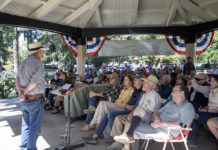A new federal program that could pump billions of dollars into
schools nationwide is being met with resistance by some local
district leaders and approached with cautious optimism by
others.
The Race to the Top program, which has states competing for a
share of the $4.3 billion in federal funding, is aimed at amping up
student achievement.
President Barack Obama and U.S. Secretary of Education, Arne
Duncan in July announced that states leading the way on school
reform would be eligible to compete for a share of $4.3 billion in
Race to the Top competitive grants to support education reform and
innovation in classrooms, according to a press release from the
Department of Education.
“This competition will not be based on politics, ideology, or
the preferences of a particular interest group. Instead, it will be
based on a simple principle – whether a state is ready to do what
works.
“We will use the best data available to determine whether a
state can meet a few key benchmarks for reform – and states that
outperform the rest will be rewarded with a grant. Not every state
will win and not every school district will be happy with the
results. But America’s children, America’s economy, and America
itself will be better for it,” Obama said in a speech at the U.S.
Department of Education headquarters in Washington, when he
announced the grant program.
But, those who applied for the grant money – in California, 44
percent of charter schools, school districts and county offices –
don’t know all of the rules that will be set by the government for
schools that are “rewarded with the grant.”
“There are too many unknowns,” said Keller McDonald,
superintendent of West Sonoma County Union High School District.
“When districts were asked whether or not they wanted to
participate, there was no state Race to the Top activity plan
presented, and no budget for it. There still isn’t. We didn’t know,
and still don’t know, and districts that signed up for Race to the
Top don’t know exactly what they will be asked to do, or how much
(money) they will receive to do it,” said McDonald, who leads a
district that chose not to apply.
On the other hand, district officials that did apply and later
decide to change their minds can withdraw at no penalty according
to the state; therefore Healdsburg and Windsor unified school
districts went after what may become an important revenue
source.
“The greatest selling point for our district is the district can
opt out of the Race to the Top (after all the rules have been
defined),” said Jeff Harding, superintendent of the Healdsburg
Unified School District. “So it’s like a no-risk guarantee. … There
are four requirements, and in philosophy, we didn’t oppose any of
them,” he said. However, the superintendent added, “Any change to
the teacher evaluation system would certainly involve an agreement
with the teachers association.”
The Race to the Top program has four basic goals: to create
demanding curriculum standards and student achievement assessments
across the nation; to improve training for teachers and
administrators; to incorporate student achievement measures into
the evaluation of teachers and administrators; and to improve the
poorest performing schools.
Harding said Healdsburg Unified School District is already doing
the first two requirements mentioned above, and the district
doesn’t have a school in the lowest performing band, so that part
of the equation doesn’t apply to Healdsburg Unified anyway.
“School districts were given a very short time line and not much
information to make what could be a critical decision,” Harding
said. “But we had to (make a decision), and because we had an
opt-out opportunity we didn’t want to leave resources
untapped.”
Windsor Unified School District Superintendent Steve Herrington
expressed similar sentiments: “The district and its teachers
association filed a letter of intent because we believe that our
current practices would be in align with those suggested in the
current guidelines. We are currently using teacher designed
assessment data and standardized assessment data to drive
instruction … and if they are going to be making a list of new
demands on top of what we are already doing, we believe we can opt
out. We don’t believe we need to add another layer to what we are
currently doing.
“I will just be waiting in April for the rules to come out to
see what they will be asking of us. If you weren’t on the list you
can’t eat from the table, so we wanted to make sure we could get
our serving.”
Addressing the component that essentially intertwines teacher
evaluations with student achievement, Herrington said, “that is a
negotiable item that I am sure we can work on developing common
language for. There are going to be multiple measures for
evaluation.”
McDonald, however, is under the impression that student
achievement would be the main measure for evaluating teachers and
administration – and shouldn’t be. “There should be additional
things considered,” he said. “For example, a teacher who volunteers
to teach in a persistently low-performing school may be a fantastic
teacher, but the student may not show huge amounts of growth, or be
performing at grade level. That is not the teacher’s fault, and
that shouldn’t be the entire basis of the evaluation.
“I totally disagree with, and have no faith in the way the Race
to the Top Program was rolled out at the state level. It has not
been well planned and it appears to me to be a reaction to federal
funding, rather than a proactive plan to improve schools.”








